Most people love the idea of baking with sourdough because they see pictures of beautiful artisan loaves with deep crust, slashes, and all the rest. And then the reality of their bread is a flat, weird situation that is not quite what they expected. Anyone else?
It’s time to end that sadness forever. Because once you master this bread machine sourdough recipe, you’ll have a foolproof loaf you’ll be proud of every time.
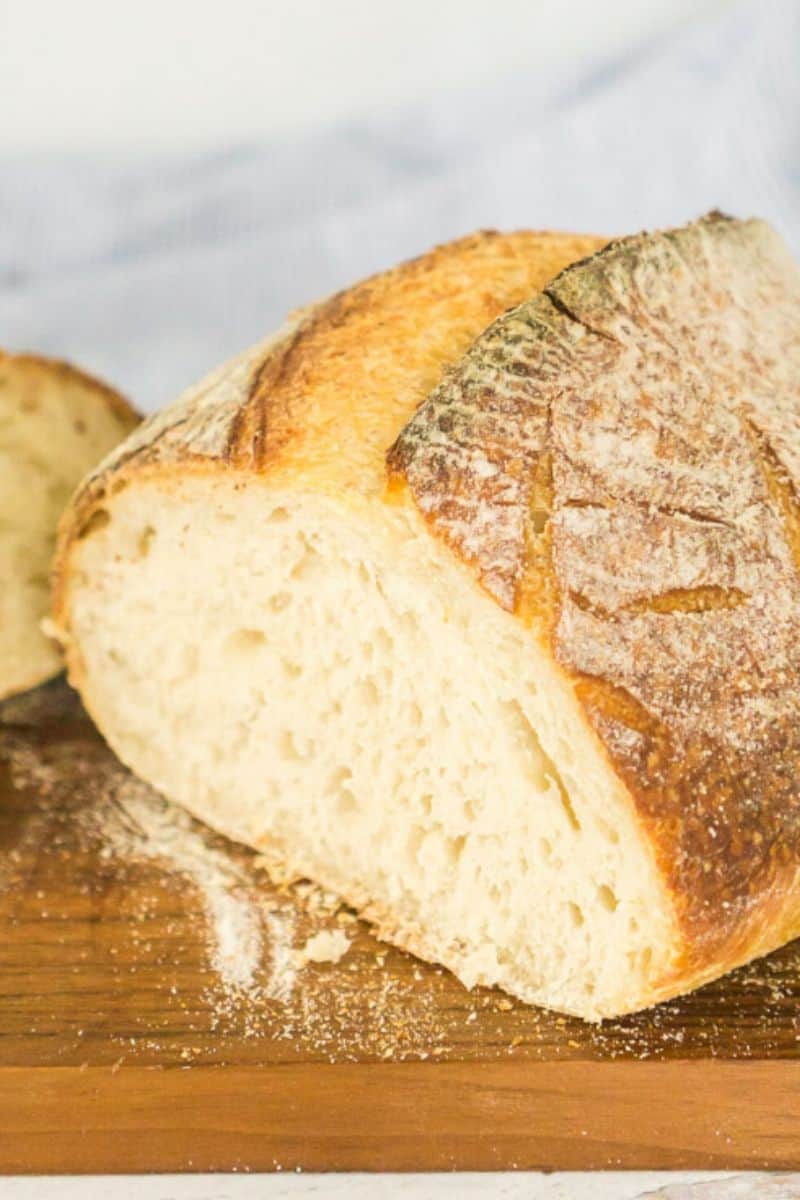
Over time, this has become my go-to for daily baking. It’s incredibly easy, especially since my bread machine handles most of the kneading. With just a few basic ingredients and letting the dough rise overnight in the fridge, I always end up with a crispy loaf on the outside and soft and chewy inside.
It’s perfect for sandwiches, toast, or even just a buttered slice. At first, the dough might seem a bit dry, but I’ve learned that’s completely normal. Resist the urge to add extra water and trust the process, and it turns out perfectly every time.
Ingredients and Tools You’ll Need
We’re using the bread machine to do the kneading, but you can also do it in a stand mixer. Make sure your starter is bubbly and active.

Get a Free + Pretty PDF Recipe Book
Sourdough Sunday Newsletter

Every Sunday evening I’ll send you a sourdough recipe to make that week, straight from my kitchen to your inbox.
And as a thank you for signing up, I’ll send you this e-book with beautiful printable recipes right away. Simple!
You will not be added to any other email lists or my daily newsletter. But if you’re already on my newsletter, you’re welcome to join and receive both.
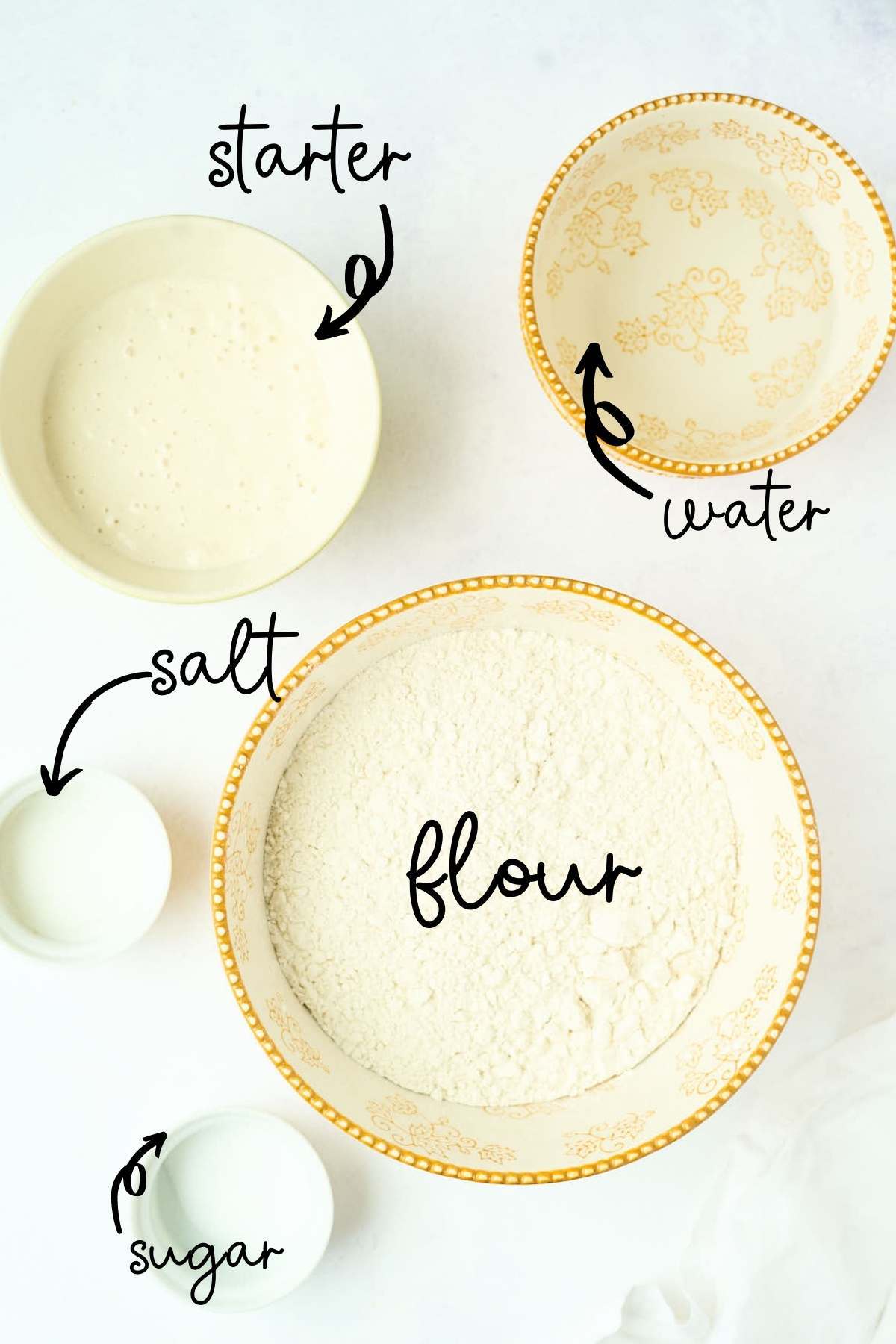
Heart’s Content Farmhouse is a participant in the Amazon Services LLC Associates Program, an affiliate advertising program designed to provide a means for sites to earn advertising fees by advertising and linking to Amazon.com. This means that when you click on certain links on this site and make a purchase, I may earn a small commission at no additional cost to you. I only recommend products I genuinely believe in and would use in my own kitchen. As an Amazon Associate, I earn from qualifying purchases.
Equipment
- Bread machine (with a dough cycle setting) (It does the kneading for you. If you don’t have one, kneading by hand or using a mixer works, but a bread machine simplifies the process.)
- Large mixing bowl
- Measuring cups and spoons
- Damp tea towel or kitchen towel
- Baking Sheet
- Parchment paper
- Rimmed baking sheet
Ingredients
- 3 cups bread flour (15.85 ounces) (regular or wheat flour will work too, but bread flour will make your bread chewier and stronger)
- 1 cup lukewarm water (7.75 ounces)
- ¾ cup fed sourdough starter (5.65 ounces) (You can also easily make your own at home with flour and water—it takes about 5-7 days to get a strong starter going.)
- ½ tablespoon sugar
- 1 ¾ teaspoon salt
How to Make Bread Machine Sourdough
Step One: Autolyze
Combine the bread flour, sourdough starter, sugar, and water in a large mixing bowl. The dough will feel drier than typical sourdough—this is normal. Do not add more water. Use your hands to make sure all ingredients are incorporated into a cohesive ball. Cover the bowl with a damp tea towel and let the dough rest on the counter for 30 minutes. Tip: Pre-measure the salt and place it in a small container on the towel to remind yourself to add it later.
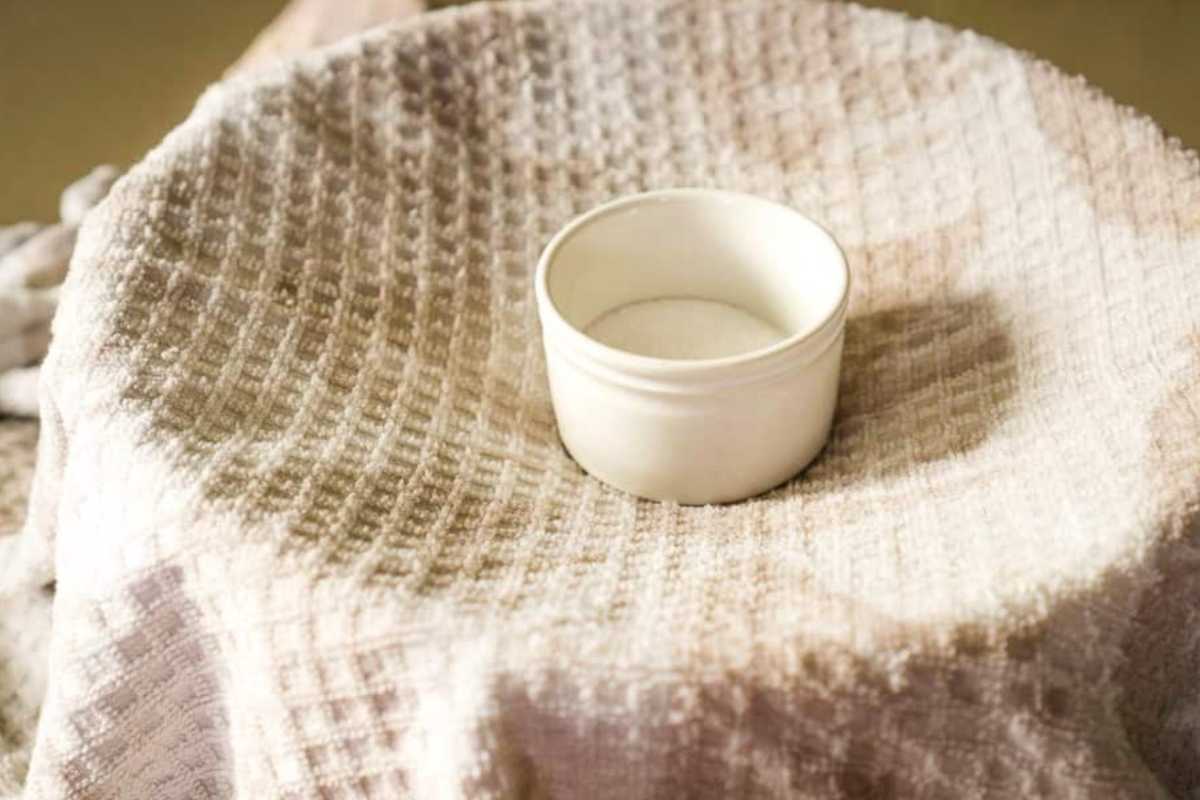
Step Two: Knead
After the autolyze, transfer the dough and salt into the bread machine bucket. Then, select the “dough” cycle and press start. You don’t need to fold the dough or anything crazy like that. Just walk away.
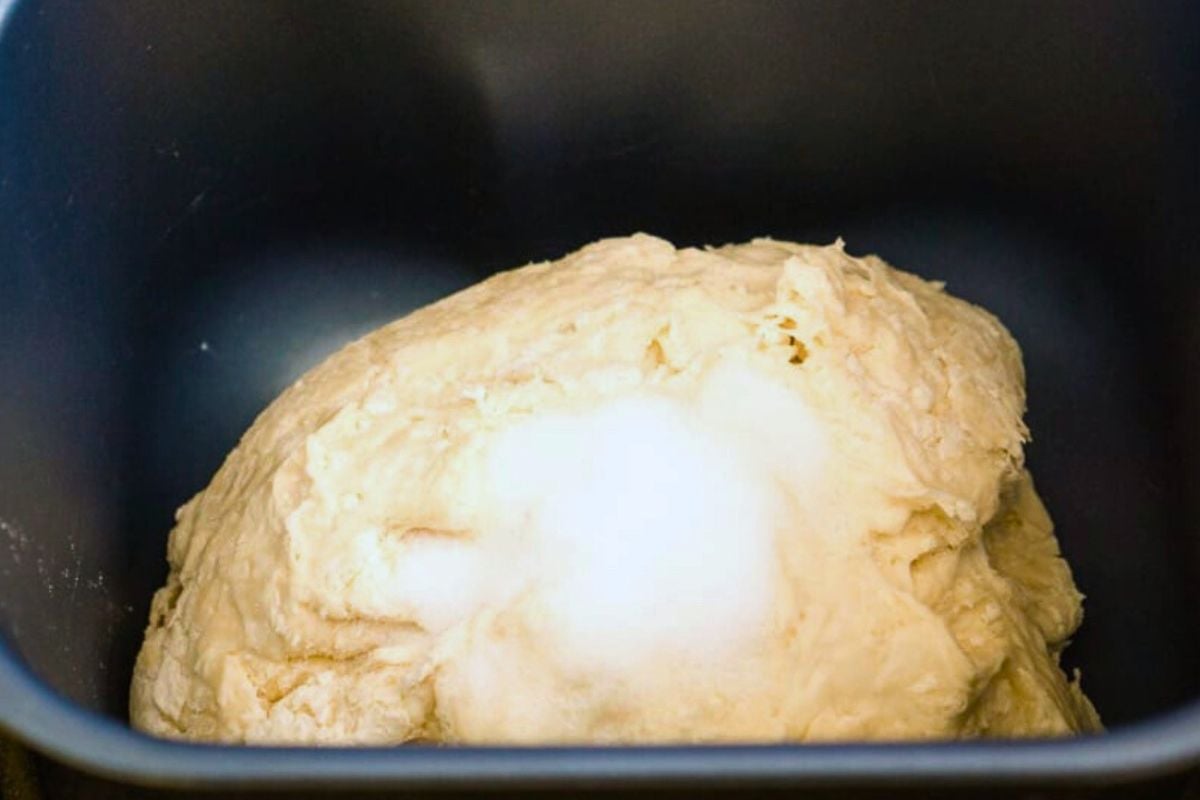
Step Three: First Rise
When the cycle ends, leave the dough in the machine to continue rising for 2-3 more hours. The dough should be noticeably puffier and soft to the touch, though it may not have doubled in size. This longer rise helps develop the flavor and texture of the bread.
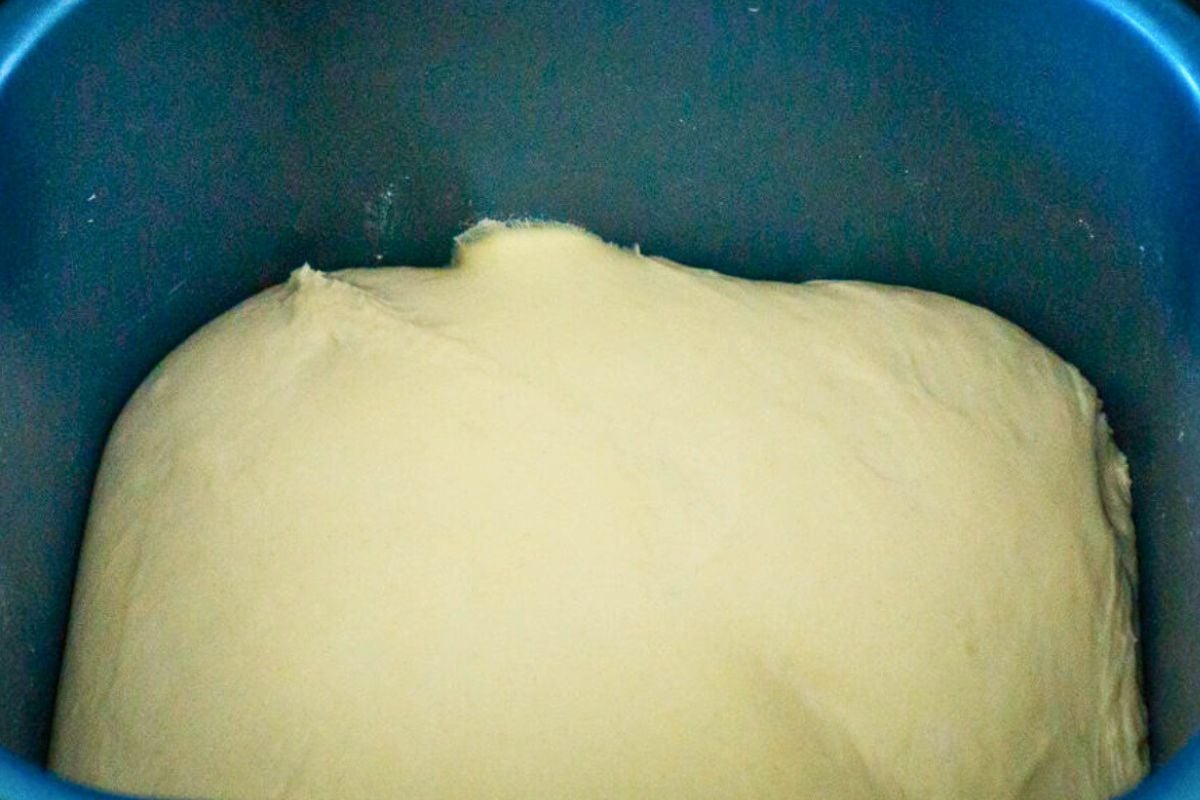
Step Four: Shape The Loaf
Prepare a baking sheet by lining it with parchment paper and sprinkling cornmeal over the surface. Carefully remove the dough from the bread machine and gently shape it into a round or oval loaf. The dough will be slightly sticky, but avoid using flour for shaping. Place the dough on the prepared baking sheet.
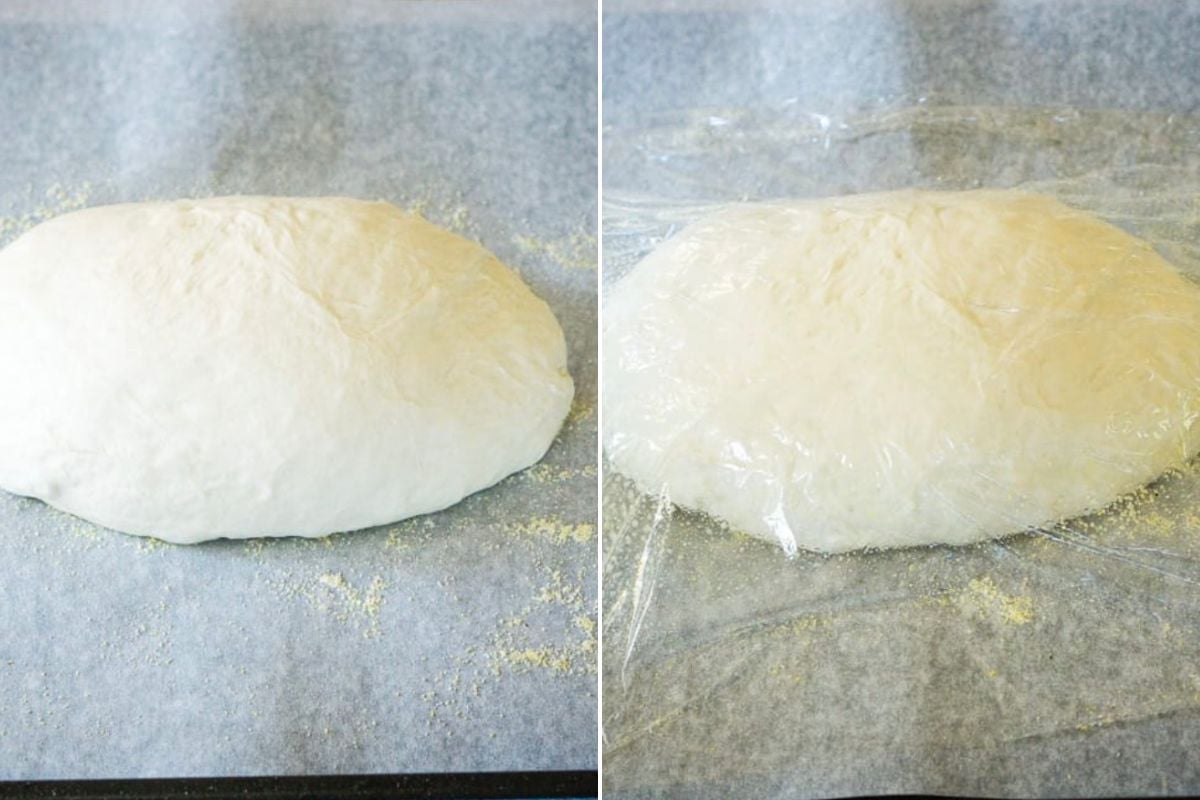
Step Five: Second Rise (Overnight Proof)
Spray a piece of plastic wrap with cooking spray and loosely cover the shaped dough. Place the covered loaf in the refrigerator to proof overnight for 8 to 16 hours.
Step Six: Prep For Baking
In the morning, preheat the oven to 450°F (230°C). Position two racks: one in the center of the oven and the other in the lower middle. Then, place an empty-rimmed baking sheet on the lower rack while the oven is preheating. Next, remove the loaf from the fridge. Dust it lightly with flour and use a lame or a sharp serrated knife to slash the top of the dough, allowing the loaf to expand during baking.
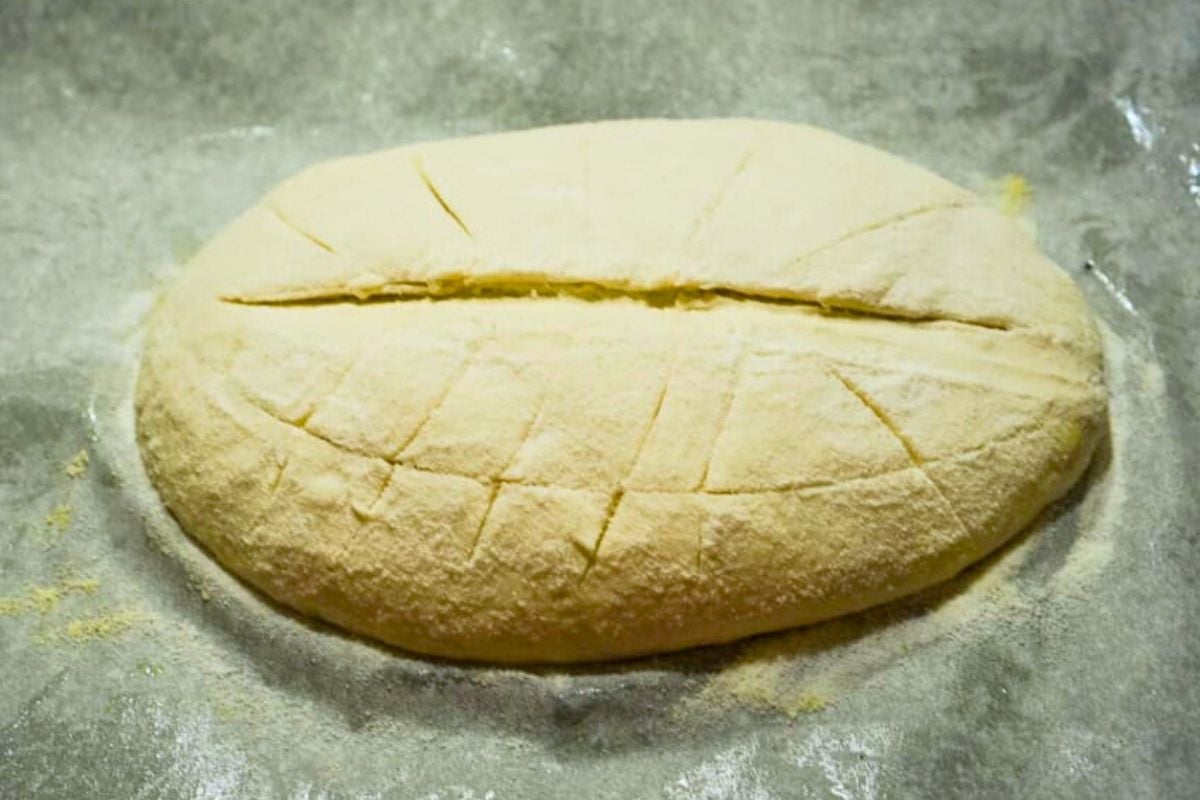
Step Seven: Bake With Steam
When the oven is fully preheated, carefully pour 1 cup of water into the baking sheet on the lower rack to create steam. Immediately place the loaf on the center rack and close the oven door. Bake the loaf for 45 minutes until it reaches a deep golden-brown color. Remove from the oven and allow the bread to cool on a wire rack for at least 4 hours.
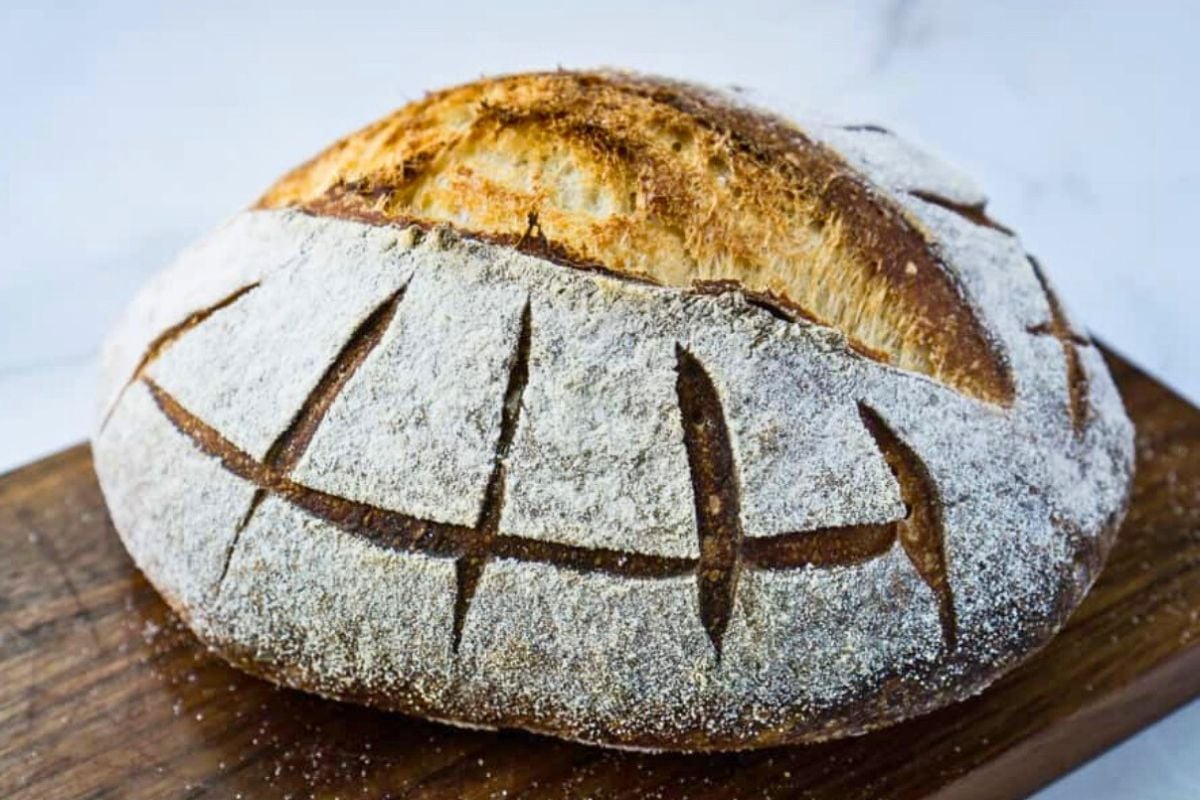
Step Eight: Slice And Serve
Once the bread has fully cooled (after at least 4 hours), use a sharp, serrated knife to slice the loaf into even pieces. Enjoy fresh or toasted with your favorite toppings!
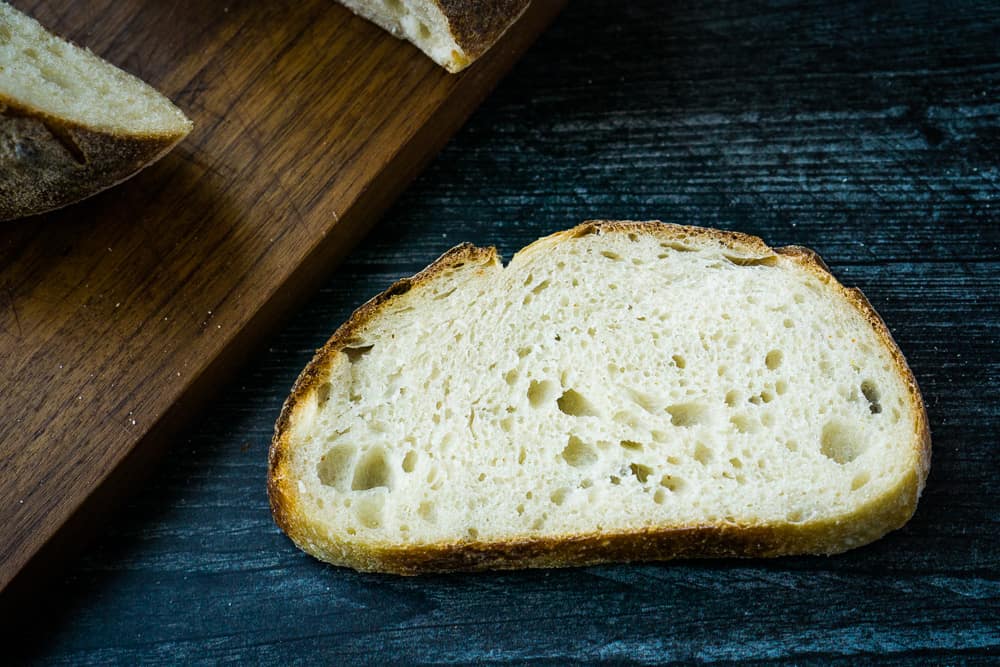
Storage Instructions
Once the bread has completely cooled, wrap it in a clean kitchen towel or place it in a paper bag. This will help keep the crust crispy while preventing the bread from drying. Avoid using plastic, as it can cause the crust to become soft. Stored this way, the bread will stay fresh for about 3 days at room temperature.
You can also freeze it. First, let the loaf cool completely. Then, slice the bread into pieces, so it’s easier to use later. Wrap the slices tightly in plastic wrap or aluminum foil and place them in a freezer-safe bag. Remove as much air as possible before sealing the bag. The bread can be stored in the freezer for up to 1 month.
Thaw the slices at room temperature or pop them straight into the toaster. You can also reheat them in the oven for a few minutes to freshen up the crust.
What to Serve with Bread Machine Sourdough Bread
This bread is great for everything from toast at breakfast to a side at dinner.
- Spread on some homemade butter or strawberry jam.
- It’s great for grilled cheese sandwiches since it doesn’t have big holes.
- Serve as a side for dinner, like with a creamy chicken noodle soup.
Questions and Troubleshooting
Check my Sourdough FAQ page to see what could have gone wrong.
The autolyze step helps improve the dough’s texture, but if you’re short on time, you can throw everything in the bread machine and still get a great loaf.
No! It’s normal for this particular recipe. Once it rests and rises, the dough will soften and be easier to work with.
Great question! The dough should look noticeably puffier, but doesn’t need to double in size. If you press it gently with a finger and it springs back slowly, it’s ready.
Yes, you can! If you’re in a rush, let the dough rise at room temperature for another 2-3 hours. The slow, overnight rise helps develop the sourdough flavor, so try it when you can.
There are a couple of reasons this could happen. If your starter wasn’t bubbly and active when you used it, that could slow the rise. Also, sourdough can be slightly slow to rise, especially in cooler kitchens. If this happens, just give it more time to puff up! If you’re having trouble with your sourdough starter and wondering if it’s still alive, don’t worry! Check out this helpful guide on how to tell if you’ve killed your sourdough starter.
Yes! Some readers have baked this in the machine. But you can’t just run a cycle from start to finish. You’ll need to remove the dough to rest in the fridge overnight, then pop it back in to bake in the morning.
You sure can. The steam and baking sheet is really a workaround for those of us who don’t have one. 😊
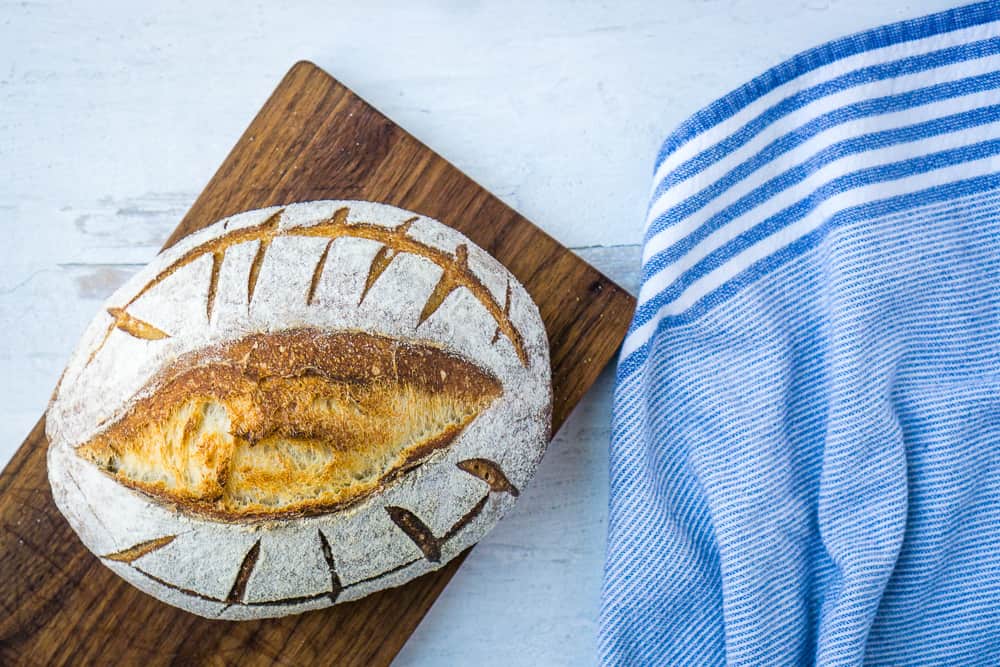
More Sourdough Recipes For Beginners
- My sourdough roll recipe uses the same steam technique and adds a pinch of instant yeast for a fluffy roll with a crisp crust.
- Sourdough baguettes are hand kneaded but also a similar process.
- And if you want to do all the crazy folding and buy some neat tools, here is a true artisan bread recipe you might like.
Printable Recipe

Bread Machine Sourdough
Equipment
- Bread machine (with a dough cycle setting)
- Large mixing bowl
- Measuring cups and spoons
- Damp tea towel or kitchen towel
- Baking Sheet
- Rimmed baking sheet
Ingredients
- 3 cups bread flour (15.85 ounces)
- 1 cup lukewarm water (7.75 ounces)
- ¾ cup fed sourdough starter (5.65 ounces)
- ½ tablespoon sugar
- 1 ¾ teaspoon salt
Save This Recipe
You'll join my email list which you will love. And if you don't, unsubscribe in one click. ❤️
Instructions
- Autolyze. Combine the bread flour, sourdough starter, sugar, and water in a large mixing bowl. The dough will feel drier than typical sourdough—this is normal. Do not add more water. Use your hands to make sure all ingredients are incorporated into a cohesive ball. Cover the bowl with a damp tea towel and let the dough rest on the counter for 30 minutes.Tip: Pre-measure the salt and place it in a small container on the towel to remind yourself to add it later.
- Knead. After the autolyze, transfer the dough and salt into the bread machine bucket. Then, select the “dough” cycle and press start. You don’t need to fold the dough or anything crazy like that. Just walk away.
- First rise. When the cycle ends, leave the dough in the machine to continue rising for 2-3 more hours. The dough should be noticeably puffier and soft to the touch, though it may not have doubled in size. This longer rise helps develop the flavor and texture of the bread.
- Shape the loaf. Prepare a baking sheet by lining it with parchment paper and sprinkling cornmeal over the surface. Carefully remove the dough from the bread machine and gently shape it into a round or oval loaf. The dough will be slightly sticky, but avoid using flour for shaping. Place the dough on the prepared baking sheet.
- Second Rise (overnight proof). Spray a piece of plastic wrap with cooking spray and loosely cover the shaped dough. Place the covered loaf in the refrigerator to proof overnight for 8 to 16 hours.
- Prep for baking. In the morning, preheat the oven to 450°F (230°C). Position two racks: one in the center of the oven and the other in the lower middle. Then, place an empty-rimmed baking sheet on the lower rack while the oven is preheating. Next, remove the loaf from the fridge. Dust it lightly with flour and use a lame or a sharp serrated knife to slash the top of the dough, allowing the loaf to expand during baking.
- Bake with steam. When the oven is fully preheated, carefully pour 1 cup of water into the baking sheet on the lower rack to create steam. Immediately place the loaf on the center rack and close the oven door. Bake the loaf for 45 minutes until it reaches a deep golden-brown color. Remove from the oven and allow the bread to cool on a wire rack for at least 4 hours.
- Slice and serve. Once the bread has fully cooled (after at least 4 hours), use a sharp, serrated knife to slice the loaf into even pieces. Enjoy fresh or toasted with your favorite toppings!
Video
Notes
Nutrition


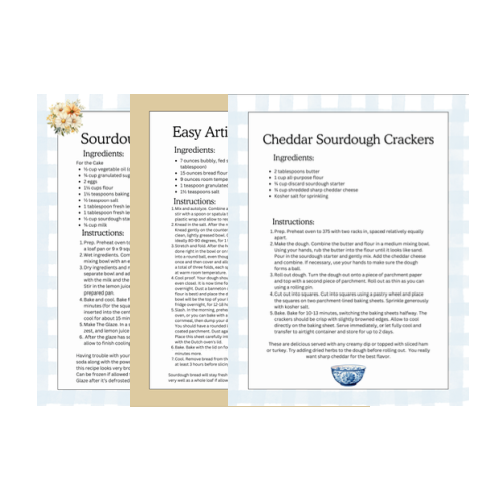

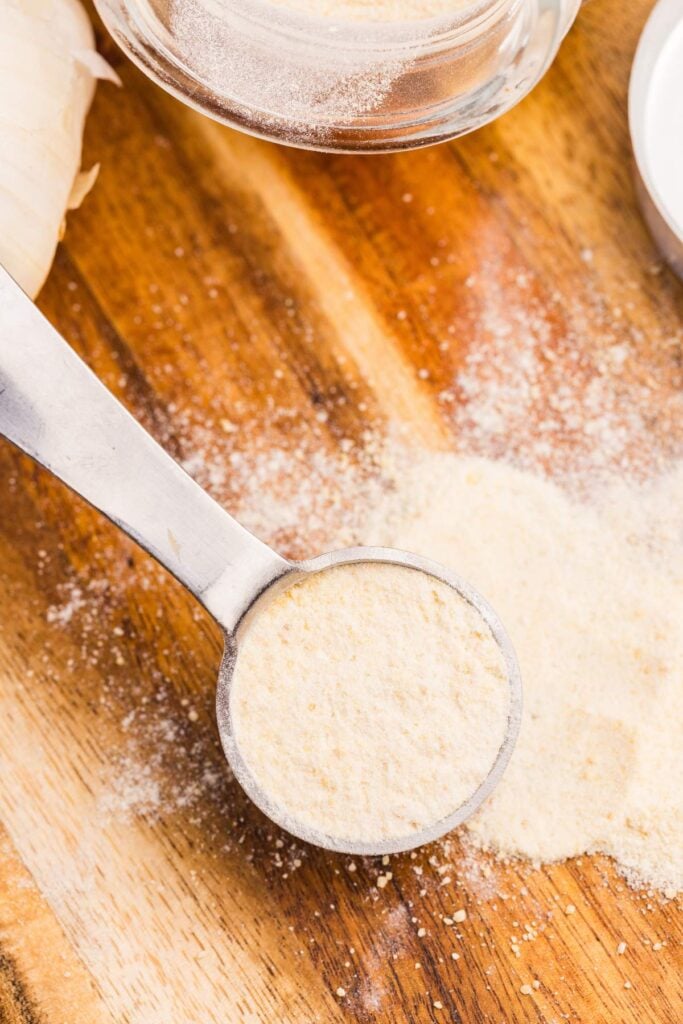


Hi Katie, I can’t wait to try this recipe. Finally a sourdough recipe that isn’t complicated. Thank you!! I just have one question, hopefully you can help me. My kids, unfortunately don’t like the sour taste of the bread, is there any way to make it less tangy. Thanks
carm I would do a 4-5 hour room temp final proof instead of the overnight proof if you like it less sour. I don’t find this recipe very sour, though, as its written. 🙂
This is my go-to sourdough bread recipe. Easy and delicious!
thank you Audrey! it is nice to find something easy that works! 🙂
I love this recipe and the simplicity of making what is normally a complicated loaf of bread!
I never have time to read these long recipe posts, I jump straight to the recipe, so I was confused about how long to wait before adding salt and had to go back and read the full blog. I wonder, could you please add the time to Step 1 – the 30 minute wait before you add salt before you put in breadmaker? Many thanks!
Brilliant! Takes very little effort and produces a superb loaf. For a change I’ve been adding a tablespoon of virgin olive oil and a tablespoon of honey to the liquid at the start.
Very pleased with your recipe, thank you
Peter I am so glad you are enjoying it. I appreciate your comment! 🙂
Wow this recipe is a 10. It’s clearly explained, really simple using the bread machine, and so delicious. I highly recommend you try this.
how kind of you Patricia! I’m glad you enjoyed it.
Love making my bread almost every day – always use this recipe and it always works unless I ‘rip’ across the risen dough. Make sure it keeps its rise by getting the dough from the bread machine carefully in one piece as far as you can and don’t stretch it too far.
I sometimes make it with 2 cups bread flour and one cup plain (all purpose) and it works just as well.
Very timely if you work full time and only have time to work it from teatime to bedtime every day.
Hi, this is the 5th time I made sourdough bread. Using your recipe, 1 time success. But it turn out sour , can I reduce the starter. Many Many thanks. Easy recipe 🙂 🙂
Try keeping it out of the fridge overnight and bake first thing in the morning – keeping it cool makes it more sour.
We quit buying store bought bread. This recipe is fantastic. Thank you so much.
Can you bake this right in the bread machine?
hi Kate, you can! you’ll need to take out the bucket and cover with plastic and have it rest in the fridge overnight after a gentle shape. then in the morning put it back in. you’ll need a machine with a bake only cycle OR to watch it and stick it on when it switches to bake 🙂
Hi,
This recipe is really good, but I was wondering if I could add some rye flour in. Would I need to adjust water amount or add any gluten powder? Also, this crust of this bread is quite tough to chew. Any suggestions for making it easier on the jaw?
Thanks
talia reduce the baking temp by 25 degrees for a softer crust. yes you can add rye. I would start w/ 10% of the total flour and increase it more each time you bake. no need to change water or anything else 🙂
Would it be the same for whole wheat flour? I have King Arthur 100% whole grain whole wheat flour with 14% protein content. Can I try replacing 10% of bread flour with the whole wheat without changing any other ingredients? Thanks.
BTW, after 2-3 epic fails in trying to knead, fold, pinch sourdough, I found your recipe. It has become my weekly bread. Thank you! (My husband thanks you too!)
Hi Carmen! Yes, substituting at 10% will be fine just as written. A few readers have gone up to 1/3 or even 1/2 whole wheat and kept everything else the same. I’m glad you’re enjoying the recipe!
I have made this several times and I appreciate how easy the low-hydration dough is! One question: when shaping the loaf, is the idea to keep the dry side up, sticky side up, or doesn’t it matter? I wasn’t sure from the recipe whether to shape on the counter first (nope, at least not with sticky side down and no flour in the counter!), or shape directly on the parchment. Then I looked at the video and saw you just shape it between your hands and not on a surface. I will try that next time, but still wondering about where the sticky side goes. Thank you!
I keep the stickier side on top because it shapes a bit smoother. but I don’t think it really matters! I’m glad you like the recipe!
Dusted off my bread machine after I friend shared some of her sourdough starter with me. Love that I can still use my bread machine without having to have any yeast on hand. Have made several of these loaves over the past few weeks and each one has turned out great!
hooray! it will be even better baking sourdough in the fall I hope!
wowwwww I’m completely blown away abt this particular sourdough recipe. I have been making sourdough for 2-3 yrs now and this bread reminded me of the bread I would buy from the local bakeries in italy. My loaf was perfect, in texture, taste and crunch. This bread is perfect for any occasion. Cant believe I been searching so long to find a great recipe for srdgh in a bread machine.This is my absolute favourite now I must find a sourdough croissant. Thank you.
I’m so happy you loved the recipe! hope you find that croissant you’re searching for ????
so easy and so good! my first successful sourdough!
Hello again, salt it says everywhere that it will kill the yeast, I am not sure that it does found an excellent croissants recipe and was amazed that the salt was added to the water and instant yeast before adding the flour etc. https://www.youtube.com/watch?v=uz_eiTIYKIg&t=6s its fool proof works perfectly every time and the resulting croissants are delicious, regards, Claudine
yes sometimes I mix the salt right in and it seems to be fine!
Hello Katie, this is just what I was looking for! why sugar? bread dough doesn’t need sugar, Australian bread machine recipes put sugar, butter and powdered milk as well as water, flour, yeast and salt, sugar, butter powdered milk are not needed and the bread works perfectly well without, I made it lots of times.
regards, Claudine
hi Claudine, yes if you want to leave out the sugar that’s no problem at all
Me – sorry. Forgot to rate!
Great recipe – many thanks. For those of us in the UK and Europe the only addition to make it perfect would be to put 230 C in brackets after 450! I suspect (but do not know) Derek (just posted) may have been using a fan oven since the jump down from 230C to 200 C is rather a big one!
great idea Iain, I’ll add that! 🙂
I have used this recipe twice and am very satisfied with the results. I use a mixture of wholemeal and plain bread flour. I think the cooking time is a little long, 35 minutes at 200C is adequate.
thanks Derek! I agree for a softer crust it can be pulled out sooner.
This was just what I needed to keep making sourdough bread…my first two were so bad I threw them out…but with your recipe and my bread machine I have a beautiful yummy bread…it looks great and it’s taste and texture are wonderful…thank you so much !
hooray! I am so glad you liked it! thanks for letting me know 🙂